#Vampire Bats
Explore tagged Tumblr posts
Text

A common vampire bat (Desmodus rotundus) in Rioverde, Mexico
by Jorge Castro Urbiola
#common vampire bat#vampire bats#bats#desmodus rotundus#desmodus#Phyllostomidae#chiroptera#mammalia#chordata#wildlife: mexico#wildlife: north america
6K notes
·
View notes
Note
can i request some vampire bats?? thank u!! i love my sharp toothed babies


“Nature’s blood banks” as one article hilariously called them!
Image Scources: {x} {x}
280 notes
·
View notes
Text



Come Have a Bite with the Vampire Bat!
Desmodus rotundus, better known as the common vampire bat, is a species of leaf-nosed bat native to Central and South America, as well as parts of the Caribbean. They are found primarily in tropical forests, particularly rainforests, but can also roam into scrubland and agricultural areas. Common vampire bats roost in hollow trees, caves, and abandoned buildings, making them a common sight in or near urban areas.
As their name implies, the common vampire bat feeds exclusively on blood, particularly those of mammals. In the wild they will feed on large animals like tapirs, but they more frequently go after domesticated animals like cattle, goats, and horses. However, when ideal prey is lacking they will also feed off lizards, turtles, snakes, toads, and crocodiles. Like most bats, D. rotundus uses echolocation to find prey. Then, special heat sensors in the nose help it to detect blood vessels close to the skin; it then bites open a small flap of the skin and drinks its fill. Its saliva contains both painkillers and anticoagulents, so victims seldom notice their host until after it has fed. Predators of D. rotundus include owls, hawks, and eagles.
Common vampire bats live in colonies of about 100 individuals, although colonies consisting of up to 1,000 individuals have been recorded. Within these colonies, males and females roost separately; females cluster in groups of 8-20, while males roost individually and guard territories against other males. However, D. rotundus is highly social, and males and females will both groom members of the same and opposite sex. This grooming can even extend to homosexual behaviours like genital licking, which is thought to reinforce hierarchies and strengthen social bonds.
D. rotundus can breed year-round, but females only raise one pup per year. Males typically mate with females in or near their defended territories. Afterwards, females carry their pregnancy for about 7 months before giving birth to a single pup. These young feed on their mother's milk for their first month; during this time, other adult females will often provide the mother with excess blood as she cannot hunt for herself. Once the pup is weaned they begin recieving blood from their mothers, and at four months they begin accompanying her on hunts. At about five months they are fully independent; females will remain in their mother's roost while males will leave to establish their own territories. Young become fully mature at about a year old, and adults may live to 12 years in the wild.
The common vampire bat is relatively plain looking, as far as bats go. They are generally gray or brown, with darker fur over their backs and dark brown or black membranes along their wings. The nose has a distinct triangle shape, which houses special heat-sensing organs. Likewise, the ears are large and triangular, used for echolocation. Adults are rather small, about 9 cm (3.5 in) long with an average wingspan of 18 cm (7 in) and a weight of 25–40 grams (2 oz).
Conservation status: The IUCN lists D. rotundus as Least Concern. In fact, populations of the common vampire bat are increasing due to the abundance of livestock as a food source.
If you like what I do, consider buying me a ko-fi!
Photos
Jose Gabriel Martinez Fonseca
Sheri & Brock Fenton
Nicolas Reusens
#common vampire bat#Chiroptera#Phyllostomidae#vampire bats#leaf-nosed bats#bats#mammals#tropical forests#tropical forest mammals#tropical rainforests#tropical rainforest mammals#urban fauna#urban mammals#central america#south america#queer fauna#nature is queer#animal facts#biology#zoology#ecology
216 notes
·
View notes
Text
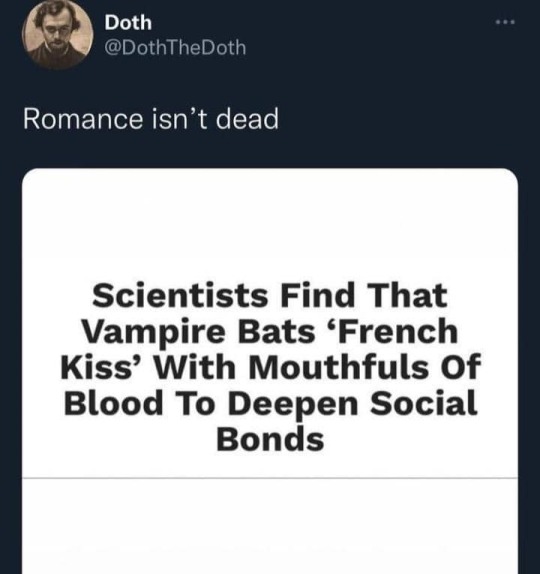
248 notes
·
View notes
Text
Yk what makes makes me sad? That when looking up "cute bats" most of them are flying foxes.
Where is my love for "ugly" bats? The cute lil creatures? I understand why people like flying foxes more cuz they look like puppies, but HAVE YOU SEEN THE LITTLE BOOP NOSES
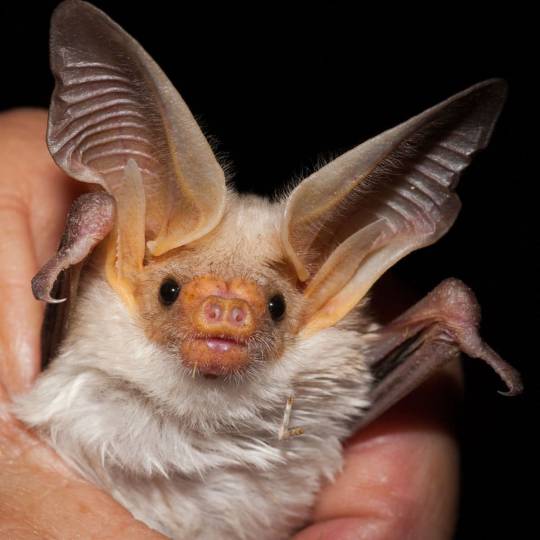

THE NOSES ARE SO BOOPABLE
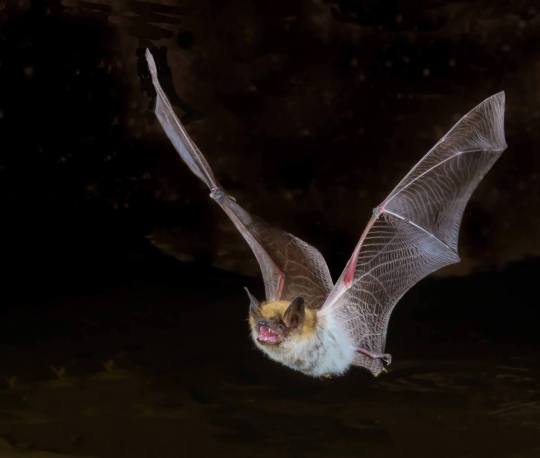
(feat. a little screming bat cuz it's adorable as fuck)
These bitches are serving cunt and you can't convince me otherwise
#goth#gothic#vampirecore#vampires#vampire community#goth rock#bat#bats#vampire bats#actually vampiric#vampiric#vampire goth#trad goth#gothic rock#80s goth#flying foxes#vampire bat#cute animals#cute bats
197 notes
·
View notes
Text
Bats are adorable, sweet and iconic.
The flying fox is a classic, pegendary and what most people think of when they hear 'Bats'. They love berries and nectar! Give'em some sweet treats this season!

Then we have the stereotyped vampire bat with their weird lil noses and very sharp teeth. They don't eat much, just some innocent sips.. OF BLOOD! Mwhahhaa

Then we have the incredibly invasive yet lovable plush bats, becareful they might not eat blood but they will empty your wallet.. Just like any good buisness!

27 notes
·
View notes
Text
The love for bats should extend more than just fruitbats. We love our fruitbats, our flying foxes. But we must also love all the bats!! The stinky ones, the creepy ones, the angry ones. The vampires, the microbats, the pipistrelle bats, the hoary bats. ALL OF THEM! They need love too.
Love the bats, all of them <3







45 notes
·
View notes
Text
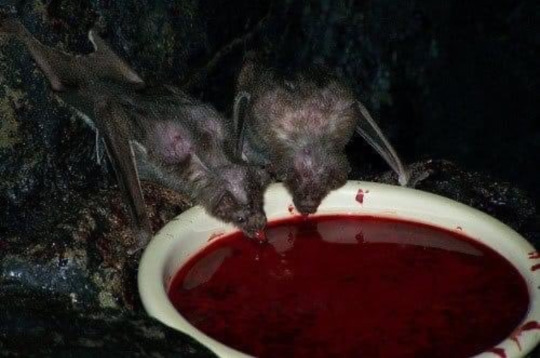
Vampires🩸
#666 satan#darkness#aesthetic#gothic#666#alternative#dark aesthetic#dark art#the devil in me#ave satanas#vampire#vampyr#vampcore#cw blood#tw blood#bloody heart#bats#cute bats#vampire bats#creepycore#scary#dark energy
109 notes
·
View notes
Text


Dean & Samm and Vampire Bats requested by Jesse. My Edit.
#dean winchester#sam winchester#supernatural#jensen ackles#jared padalecki#vampire bats#my edit#wayward sons#the winchester brothers#halloween#spooky season
22 notes
·
View notes
Text


halloween demigirl + bats
flag credit: @palatteflags
Demigirl: Someone whose gender is partially female, woman, girl, or feminine-aligned. The other part(s) of the user's gender are intentionally unspecified with this label, for a broad umbrella. May be considered a multigender or genderfluid identity.
#demigirl#demigirl pride#demigirl positivity#demigirl moodboard#queer#pride#transgender#halloween#bats#vampire bats#my moodboards#mine
21 notes
·
View notes
Text
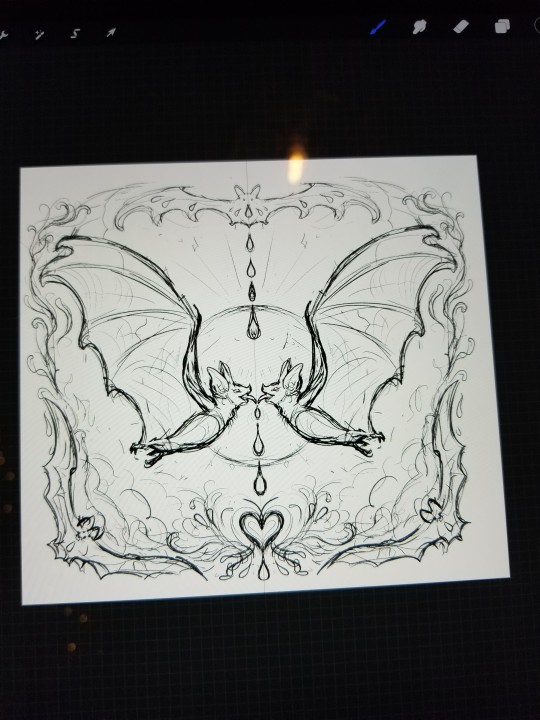
Apparently vampire bats give bloody kisses to feed eachother in times of need.
A bit more refined sketch, I think eventually I want to incorporate more red and veins, to portray their community, care and connectedness to eachother in a bat colony, gosh bats are amazing aren't they! :D
131 notes
·
View notes
Text
Could Vampire Bats Have Eaten Quincey's Horse?
I have not seen anything pulled down so quick since I was on the Pampas and had a mare that I was fond of go to grass all in a night. One of those big bats that they call vampires had got at her in the night, and what with his gorge and the vein left open, there wasn’t enough blood in her to let her stand up, and I had to put a bullet through her as she lay.
I actually misremembered this scene as Quincey saying his horse was eaten by a straight up vampire, because this doesn't make any sense at all. Vampire bats drink two tablespoons of blood nightly, they aren't draining horses.
Or are they?
Like the last time I went off on some weird scientific journey about blood consumption in Dracula, I decided to see if there's any way this is possible.
So, Quincey's horse is a mare, which has a lower average body weight than a stallion, and as such, a lesser whole blood volume. For example, "the breed standard weight for a Thoroughbred stallion is approximately 1,100 to 1,300 pounds, while mares weigh between 900 to 1,100 pounds."
What kind of mare did Quincey have, though? That impacts the weight and the amount of blood. If we assume he was using a horse from Argentina rather than bringing a horse from the United States, I think the most likely breed would be the Criollo, which is the native horse of the Pampas. If he brought a horse with him to South America, I'd wager it was an American quarter horse, the most popular horse breed among cowboys.
The Internet tells me that the average Criollo weight is between 1200 to 1300 pounds, and the average American quarter horse weighs between 950 to 1200 pounds. So let's imagine Quincey's mare weighed 1200 pounds if she was a Criollo, and 950 pounds if she was an American quarter horse.
I am told that "on average, a horse has approximately 8 to 10 percent of its body weight in blood." We'll go with 8 percent to give the vampire bats a fighting chance. This would mean a Criollo mare would have 96 pounds of blood, and a American quarter mare would have 76 pounds of blood.
There are 30.68 tablespoons in a pound. As such:
Criollo: 2945.28 tbsp
American Quarter: 2331.68 tbsp
Of course, Quincey's mare didn't lose all of her blood. She was still alive, she just couldn't get up. So what's the maximum amount of blood a horse can lose and live?
According to this posting, a horse which has lost 6 to 12 L of blood can survive with a transfusion, so we'll posit that 12 L is the maximum blood loss a horse can survive. 12 L is 26.45 pounds, or 797.68 tablespoons.
It would take 399 vampire bats all feeding from the same animal to remove 797.68 tbsp of blood in one night.
The average vampire bat colony contains 100 bats. So, if four colonies descended on the mare (maybe she was the only animal out and about that night) then this is actually possible.
But more likely Bram Stoker had no idea how vampire bats worked a Argentinian vampire was feeding on tourists and their horses, knowing the bats would be blamed.
29 notes
·
View notes
Text
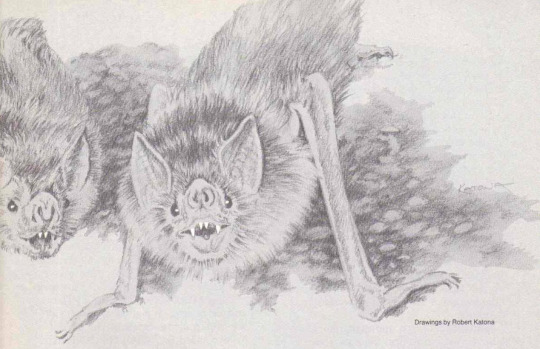
Ranger Rick's Nature Magazine; November 1979 edition. Illustration by Robert Katona.
Internet Archive
173 notes
·
View notes
Text
Uncharismatic Fact of the Day
There's nothing to fear from the hairy-legged vampire bat, unless you happen to be a bird! Like their more infamous cousin, the common vampire bat, hairy legged vampire bats are sanguivorous. However, they feed almost exclusively on birds; individuals use special heat-sensing organs in their noses to locate nests, and often their victims are completely unaware of being bitten due to the bat's saliva, which contains a number of anticoagulents and numbing agents.

(Image: A colony of hairy-legged vampire bats (Diphylla ecaudata) by Rene Carpio Real)
#hairy-legged vampire bat#Chiroptera#Phyllostomidae#vampire bats#new world leaf nosed bats#bats#mammals#uncharismatic facts
115 notes
·
View notes
